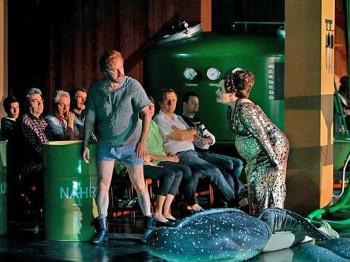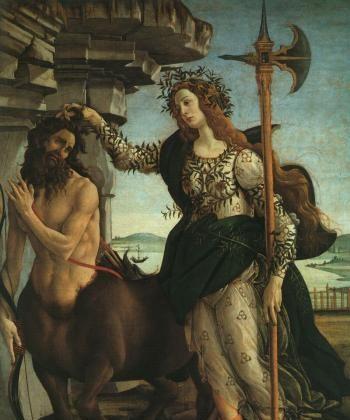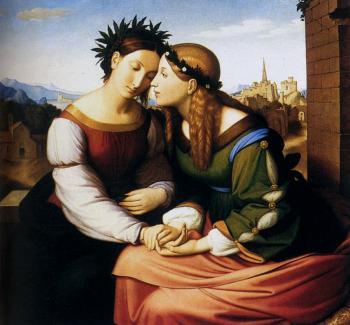While in America Halloween is a big festivity, Walpurgis Night is a celebration that became a signature event for a special region in middle Germany, the Harz mountains.
It’s said that on Walpurgis night, the witches gather to celebrate a party. Flying on brooms, muckrakes, cats, or other animals, they come to the top of the Brocken, the highest mountain of the region. There, they dance around a huge fire and worship their lord and groom, the devil, who bestows them with new magic power.
The name Walpurgis derived from a catholic Saint, Walpurga. She lived as a Benedictine abbess in 8th century Germany and had absolutely nothing to do with the celebration—until she gained the reputation to protect from evil ghosts and the church decided to make her the patron of May 1.
Today it’s accepted that Walpurga served as a placebo for an old pagan spring goddess. In its origins the celebration was seen as the wedding of the German gods Wotan and Freya that expels the winter, the connection to the marriage between the devil and the witches becomes obvious. Many a costume around Walpurgis serves for enhancing fertility or promoting relationships between the sexes—so it was no wonder that the church saw demonic potential in this spring customs and tried to bring them into civilized manners.
Historically, it is most likely that the “witches“ celebrating on the Brocken were ordinary humans that were forced to Christianity by Charlemagne. They still adhered to their pagan religion and went secretly in the mountains to worship their gods—hooded or masked to protect themselves.
In a positive old approach these “witches“ helped with their dancing round the fire to melt the last snows of winter. Today Walpurgis Night means that people dance around fires and wear masks to scare the witches away.
Though the old inhabitants had a deep connection to the land, the Harz region’s history became a man-versus-nature story: Once a forest were only people favored by the Emperor Charlemagne were allowed to hunt, forest clearings of the Middle Ages led to destruction and environmental problems continuing until today. In 1852, a formation of rocks called “The devils wall” situated in the village Thale had to be put under protection by law, as people of surrounding villages had started to break stones from there. Thus the legends around the place had helped to save a natural monument.
Writer Johann Wolfgang von Goethe (1749-1832) unintentionally opened the chapter of Walpurgis tourism on Brocken Mountain, when he put the setting of the Walpurgis Night scene from his drama Faust up there.
This literary witch-party finally inspired people to go, dressed as witches and devils, to the actual nature side to party.
The first organized event of that kind dates back to 1896. Since 1899 a train was in operation that brought the partygoers to the mountaintop. In 1901 the Prince von Stolberg-Wernigerode, owner of the Brocken, gave it a last try to prohibit the annual party. At the beginning of the 20th century, lovers of the landscape urged for declaring the Harz and the Brocken as the first national park in Germany, as nature had seriously suffered from the development.
Goethe’s Walpurgis Night from ‘Faust’
It’s hard to imagine that in the time when the young Goethe wandered to the top of the Brocken, he was one of about 400 visitors per year. The loneliness he felt amidst the vastness of nature shines through his lines: “Thus lonely, I said to myself ... will feel the man in his heart, who wants his soul to open only to the most ancient, serious, first and deepest feelings of truth.”
Goethe’s famous Walpurgis Night text became just the opposite of that silence:
The devil takes Faust amidst the excessive party of witches to make him forget about his unhappy love. The scene was once regarded as shocking and because of its expletives and innuendos it had to be performed in a censored version. Self-confident Goethe made fun of people’s witch fantasies and took the opportunity to make digs at his contemporaries the same time: As the evil in the cosmic hierarchy is most incompetent and promotes ugliness, Goethe’s devil says for example to a bad writer: “I’m glad to find you here, this is where you belong...”
He further more puts some type of outraged rationalist in the midst of the hurly-burly, who complains that the witches are still dancing—in the rationalist’s view, the witches shouldn’t have survived the Enlightenment movement. Goethe himself promoted the idea of a universally animated nature and that way exposed the radical rationalists as narrow-minded.
200 years after Goethe, one can book a Walpurgis Night, including wellness hotel and buy a witch souvenir everywhere, but the deep meaning of the old spring celebration has gone. It became a commercial mix where good and evil cannot be told apart any longer.



